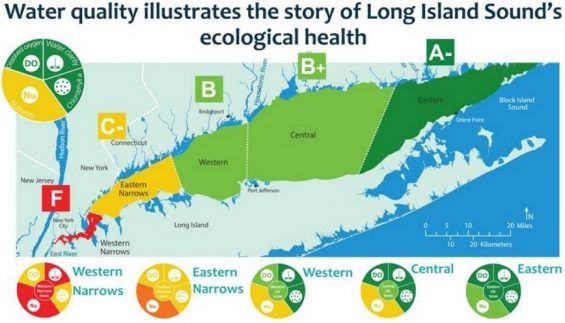
Oct. 17, 2016 By Hannah Wulkan
The Long Island Sound water quality near Queens leaves something to be desired, according to a recent report.
In findings released by the non-profit group Save the Sound, the Western Narrows section of the sound, which includes part of the East River, scored an “F” for overall water quality.
The report examined several aspects of water quality, including the levels of dissolved oxygen, the levels of nutrients in the water, the chlorophyll levels and water clarity. While much of the Sound scored fairly well, the Western Narrows scored poorly on all tests.
“Estuaries like those surrounding Long Island Sound are some of the most productive ecosystems in the world. The issues that arise from being surrounded by densely populated areas threaten their survival,” said Congressman Joe Crowley at the report card announcement in Flushing earlier this month.
“New York City made recent investments in sewage treatment to reduce nitrogen entering the Sound, including upgrades at the Tallman Plant in College Point, and the U.S. Army Corps of Engineers recently agreed to our request to remove junk barges and open the federal navigation lanes. While I’m glad to see progress, I hope future Report Cards will show improved water quality as new technologies and upgrades come online,” Crowley added.
The Western Narrows runs from where the East River begins to flush in to the Sound near the Triborough bridge to a line between Sands Point on Long Island to the northern end of Pelham Bay Park on the mainland.
According to the report card, this section of the Sound is shallow and is extremely inefficient at flushing in to the rest of the Sound, leaving pollution from the city sitting in the river with nowhere to go.
“With this science-based report card, we can track our progress in restoring Long Island Sound,” said Dr. Bill Dennison, a scientist at the University of Maryland Center for Environmental Science, who designed the ecosystem report card process.
“It’s an amazingly productive body of water historically. Eastern Long Island Sound is doing very well with abundant aquatic life. We could see that happening if we continue to ramp-up stormwater work and sewage treatment. We haven’t done enough to clean up the Sound and this report card will track the progress over time,” he added.
Save the Sound has tracked the progress of pollution in the Sound since 2013 and has seen some improvements in certain areas, though the Western Narrows section has maintained an F letter grade throughout.
One Comment

No wonder I can never catch any fish at the park.